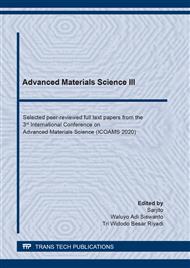[1]
Z. A. AL-Othman, R. Ali, and M. Naushad, Hexavalent chromium removal from aqueous medium by activated carbon prepared from peanut shell: Adsorption kinetics, equilibrium and thermodynamic studies,, Chem. Eng. J., vol. 184, p.238–247, (2012).
DOI: 10.1016/j.cej.2012.01.048
Google Scholar
[2]
G. Wang et al., Removal of Pb(II) from aqueous solutions by Phytolacca americana L. biomass as a low cost biosorbent,, Arab. J. Chem., vol. 11, no. 1, p.99–110, (2018).
DOI: 10.1016/j.arabjc.2015.06.011
Google Scholar
[3]
Ş. Taşar, F. Kaya, and A. Özer, Biosorption of lead(II) ions from aqueous solution by peanut shells: Equilibrium, thermodynamic and kinetic studies,, J. Environ. Chem. Eng., vol. 2, no. 2, p.1018–1026, (2014).
DOI: 10.1016/j.jece.2014.03.015
Google Scholar
[4]
M. Ghasemi, M. Naushad, N. Ghasemi, and Y. Khosravi-fard, A novel agricultural waste based biosorbent for the removal of Pb(II) from aqueous solution: Kinetics, equilibrium and thermodynamic studies,, J. Ind. Eng. Chem., vol. 20, no. 2, p.454–461, (2014).
DOI: 10.1016/j.jiec.2013.05.002
Google Scholar
[5]
F. Fu and Q. Wang, Removal of heavy metal ions from wastewaters: A review,, J. Environ. Manage., vol. 92, no. 3, p.407–418, (2011).
Google Scholar
[6]
D. H. K. Reddy, Y. Harinath, K. Seshaiah, and A. V. R. Reddy, Biosorption of Pb(II) from aqueous solutions using chemically modified Moringa oleifera tree leaves,, Chem. Eng. J., vol. 162, no. 2, p.626–634, (2010).
DOI: 10.1016/j.cej.2010.06.010
Google Scholar
[7]
T. Depci, A. R. Kul, and Y. Önal, Competitive adsorption of lead and zinc from aqueous solution on activated carbon prepared from Van apple pulp: Study in single- and multi-solute systems,, Chem. Eng. J., vol. 200–202, p.224–236, (2012).
DOI: 10.1016/j.cej.2012.06.077
Google Scholar
[8]
S.-A. Sajjadi et al., A novel route for preparation of chemically activated carbon from pistachio wood for highly efficient Pb(II) sorption,, J. Environ. Manage., vol. 236, p.34–44, (2019).
DOI: 10.1016/j.jenvman.2019.01.087
Google Scholar
[9]
M. I. A. A. Maksoud, A. M. Elgarahy, C. Farrell, H. Ala'a, D. W. Rooney, and A. I. Osman, Insight on water remediation application using magnetic nanomaterials and biosorbents,, Coord. Chem. Rev., vol. 403, p.213096, (2020).
DOI: 10.1016/j.ccr.2019.213096
Google Scholar
[10]
O. A. Ramírez Calderón, O. M. Abdeldayem, A. Pugazhendhi, and E. R. Rene, Current Updates and Perspectives of Biosorption Technology: an Alternative for the Removal of Heavy Metals from Wastewater,, Curr. Pollut. Reports, vol. 6, no. 1, p.8–27, (2020).
DOI: 10.1007/s40726-020-00135-7
Google Scholar
[11]
T. Mutiara, F. I. Muhandi, A. Alhumaini, A. Chafidz, and P. Hidayat, Removal of Lead (Pb2+) from Aqueous Solution Using Bio-Biosorbent Prepared from Cassava Stem Pith,, in Materials Science Forum, 2020, vol. 981, p.331–335.
DOI: 10.4028/www.scientific.net/msf.981.331
Google Scholar
[12]
F. A. Putri, N. F. Hamadi, A. Y. D. Lestari, A. Chafidz, and T. Mutiara, Potential of Modified Corn Cob (Zea mays L.) and Petai Hull (Parkia hassk) as New Biosorbent for Removal of Lead Waste,, in Key Engineering Materials, 2018, vol. 783, p.126–131.
DOI: 10.4028/www.scientific.net/kem.783.126
Google Scholar
[13]
A. Chafidz, W. Astuti, V. Augustia, D. T. Novira, and N. Rofiah, Removal of methyl violet dye via adsorption using activated carbon prepared from Randu sawdust (Ceiba pentandra),, IOP Conf. Ser. Earth Environ. Sci., vol. 167, p.12013, (2018).
DOI: 10.1088/1755-1315/167/1/012013
Google Scholar
[14]
A. Shukla, Y.-H. Zhang, P. Dubey, J. L. Margrave, and S. S. Shukla, The role of sawdust in the removal of unwanted materials from water,, J. Hazard. Mater., vol. 95, no. 1, p.137–152, (2002).
DOI: 10.1016/s0304-3894(02)00089-4
Google Scholar
[15]
U. Knuutinen and P. Kyllonen, Two case studies of unsaturated polyester composite art objects,, e-Preservation Sci., vol. 3, p.11–19, (2006).
Google Scholar
[16]
S. Hermanto, Mengenal Lebih Jauh Teknik Analisa Kromatografi dan Spektroskopi,, Fak. Sains dan Teknol. Jakarta, (2009).
Google Scholar
[17]
I. Safrianti, N. Wahyuni, and T. A. Zaharah, Adsorpsi timbal (II) oleh selulosa limbah jerami padi teraktivasi asam nitrat: pengaruh pH dan waktu kontak,, J. Kim. Khatulistiwa, vol. 1, no. 1, (2012).
Google Scholar
[18]
G. A. Wardani and W. T. Wulandari, Pengaruh waktu kontak terhadap daya adsorpsi kulit jengkol (Pithecellobium jiringa) pada ion timbal (II),, in Prosiding Seminar Nasional Kimia UNY-2017, 2017, p.319–324.
DOI: 10.22487/j24775398.2017.v3.i3.8592
Google Scholar
[19]
A. Ahmad, M. Rafatullah, O. Sulaiman, M. H. Ibrahim, Y. Y. Chii, and B. M. Siddique, Removal of Cu(II) and Pb(II) ions from aqueous solutions by adsorption on sawdust of Meranti wood,, Desalination, vol. 247, no. 1, p.636–646, (2009).
DOI: 10.1016/j.desal.2009.01.007
Google Scholar
[20]
T. Mutiara, F. I. Muhandi, A. Alhumaini, A. Chafidz, and P. Hidayat, Removal of Lead (Pb2+) from Aqueous Solution Using Bio-Adsorbent Prepared from Cassava Stem Pith,, in Materials Science Forum, 2020, vol. 981, p.331–335.
DOI: 10.4028/www.scientific.net/msf.981.331
Google Scholar
[21]
T. Mutiara, I. Rofiki, and M. A. D. Al Ghifari, Bio Adsorbent from Modified Jackfruit Wood Sawdust for Removal of Lead Ions,, in Materials Science Forum, 2018, vol. 934, p.159–164.
DOI: 10.4028/www.scientific.net/msf.934.159
Google Scholar
[22]
F. A. Putri, N. F. Hamadi, A. Y. D. Lestari, A. Chafidz, and T. Mutiara, Potential of Modified Corn Cob (Zea mays L.) and Petai Hull (Parkia hassk) as New Biosorbent for Removal of Lead Waste,, in Key Engineering Materials, 2018, vol. 783, p.126–131.
DOI: 10.4028/www.scientific.net/kem.783.126
Google Scholar


